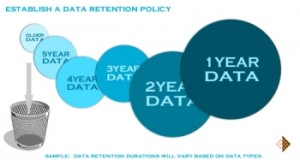 This post was originally published in November 2012 and updated August 2017.
This post was originally published in November 2012 and updated August 2017.
You may have been in this situation before. It’s 4:30 pm, three days after your Assistant Executive Vice President and/or Director of This-and-That resigned. The VanStiltskien contract was signed, scanned and emailed three weeks ago, but the executive assistant can’t find his copy, and no one else has it. You are missing some critical details and your former colleague has gone incommunicado. The data hunt begins and it may or may not be easy. What happens next is a mix of good IT policy, technology, and user management. This can be an expensive and time consuming ordeal or it can be easy.
Recently my client had a director and a VP from the same department leave in the same week. In recent years, the exit procedures for departing employees have become somewhat arbitrarily enforced. Ideally, all email and user data is backed up and archived on a CD. Normally, we don’t find out if any data is missing until months or years later when a file can’t be found, a contact is needed or a reference needs to be tracked down.
In this case, I got to see firsthand how this process should NOT happen. Both users were trying to be helpful, and purged as much of their email as possible. They moved critical files across the network to various people and departmental folders. Both users were trying to be good outgoing employees and help with the transition process. When I went to collect their data, all I found were scraps–a reduced email archive and hardly any personal files.
After a little digging, I learned what had happened. Everything was above board. But what if it hadn’t been? What if another Network Admin had come in months later? How would they know what happened to the data? Recently I had to cleanup a similar mess and it was laborious. The best of intentions are a lousy substitute for good IT policy and resource management.
These events led to some ongoing discussions at my client about how we retain data and what we do when an employee, particularly an executive (or two), leave the company. Much of it is policy that comes down from the senior leadership. They decide how much data should be kept and for how long. Afterwards the HR and IT departments are brought into the process.
Here are some critical questions you should discuss with your HR and IT departments.
- What happens to a user’s data when they leave?
- Is there a formal IT policy for departing employees?
- If yes, who makes sure it gets done? What is the timeline?
- If no, does there need to be one?
- What happens to email? Who needs a copy of the email archive? Who takes over aliases? Who answers incoming mail?
- What happens to their other files? Are they kept locally or distributed?
- Who closes out accounts and changes passwords? This is particularly important if you do not have regular IT staff.
- What steps are taken if/when an employee is forcibly terminated?
- Are there procedures in place to prevent electronic vandalism and theft?
These questions are right up there with collecting office keys and cutting the final paycheck. Each employee leaves a data trail, and expectations need to be set about how this data is handled. You should carefully consider what data needs to be kept, for how long, and who has access to that information.
